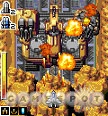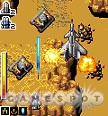Mforma's original Top Gun Air Combat game, which came out more than a year ago, was arguably the smash success that put the San Diego-based company over the top. Now that it has grown into one of the world's largest mobile games publishers, Mforma is attempting to revisit its heady triumph with the inevitable sequel, Top Gun Air Combat II. Top Gun fans will be happy to know that Mforma has successfully avoided fixing what's not broken. Although its visuals have been updated for the new generation of hardware, Top Gun Air Combat II delivers essentially the same delicately balanced gameplay with a few minor tweaks. As a result, Top Gun Air Combat II is a great pick if you're looking for a traditional shooter on mobile.
At the beginning of Top Gun Air Combat II, you choose between two famous flyboys, each of whom hails from the monumental, Reagan-era Tom Cruise vehicle. Maverick's plane is the more maneuverable of the two, but Iceman's craft wields a more powerful (albeit slower) cannon. The game experience doesn't vary too significantly with your choice of pilot--especially since Maverick and Iceman actually get more alike as you upgrade their aircraft--but they do use somewhat different special weapons and fly at slightly different speeds, so it's worth trying out both.
Once you've made your decision, you are thrust airborne to track down and destroy your first target: an enormous, Flying Fortress-esque dreadnought called the T-Rex. Along the way to each level boss, you'll have to stiff-arm your way past crowds of interceptors, which can vary from small fighters to larger gunships and helicopters to Earth-based enemies like subs and tanks. Chasing after the T-Rex isn't that big of a deal, but starting on level two, the volume of enemies and their ordinance you have to deal with increases dramatically. Your plane can absorb several normal shots before its fuel/life meter depletes. However, you must restart a level from the beginning every time you die by loading your previously saved game, so it pays to use every trick at your disposal.
Auto-fire and quick maneuvering alone aren't enough to keep your bird flying in Top Gun Air Combat II; you must aggressively upgrade your weapons between levels to stand up to the continued redoubling of resistance. The hangar offers three different weapon upgrades--an augmentation of your normal cannon, a power shot, and spread rockets--each of which can be boosted up to three times. You pay for the upgrades with medals you collect during the course of play by blowing up certain types of enemies. However, every time you buy an upgrade, the cost of the next weapon purchase goes up by one medal. This clever system makes you choose between medals and self-preservation on a constant basis: You have to weigh the potential health cost of pursuing additional medals against the very necessary benefit of having an upgrade for the next round. You can also buy extra special weapons and replacement fuel in the hangar, adding still more variables to your calculation. Your fuel doesn't refill all the way between rounds, so if you sustain a lot of damage, it may be worth investing a medal or two to replenish it in 30-percent increments.
Top Gun Air Combat II's controls are cut from the same mold as most of the arcade shooters of yesteryear, and they are incredibly simple. Auto-fire is enabled as the default option (you can turn it off, but there's really no reason to), and you simply move your plane around the screen using the appropriate number keys. The 1 key triggers your special weapon, which takes the form of a screen-clearing, rolling explosion for Maverick and a superpowered column of fire for Iceman. Generally speaking, both planes are quick enough to maneuver around most threats, except during boss fights, which fill the entire screen with shots and necessitate a great deal of scrambling to survive. Top Gun Air Combat II has a very fluid run speed most of the time on Series 60 Java handsets like the N-Gage QD, but there are certain instances where the game runs into some bad slowdown. Unsurprisingly, the problem is particularly pronounced when there are a lot of moving planes on the screen. These periods of slowdown rarely last for more than a few seconds, but they're enough to disrupt the flow of gameplay.

Aside from the occasional slowdown problems, Top Gun II's graphics are gorgeous. This game uses color very effectively to highlight the different types of ships, and the backgrounds are also painted in an array of brilliant hues. Also, the aesthetic appeal of the larger aircraft and boss ships deserves special mention. The largest, most intimidating planes must be dismantled piece by piece, and their different components smolder and explode as you take them apart. The game's handful of simple electronic tones are underwhelming, but they do provide a bit of much-appreciated auditory feedback.
Overall, Top Gun Air Combat II does a great job of working within the confines of its simple gameplay model. There aren't many original ideas here, but the execution is almost uniformly top-notch. Plus, this game is hard enough to supply even avid mobile gamers with several hours of action, making it an excellent value. If you're looking for a familiar, action-packed shooter, you won't go wrong downloading Top Gun Air Combat II.
